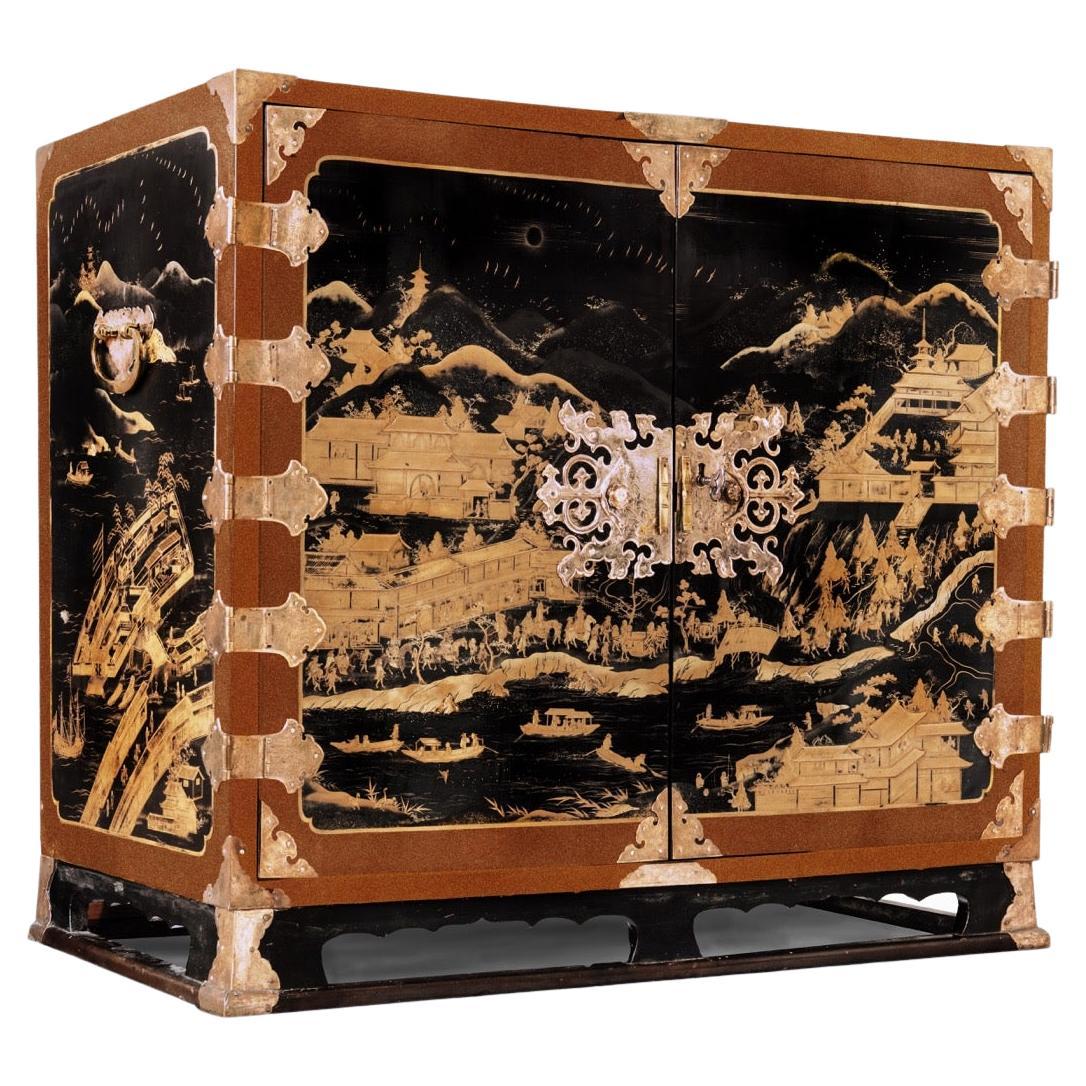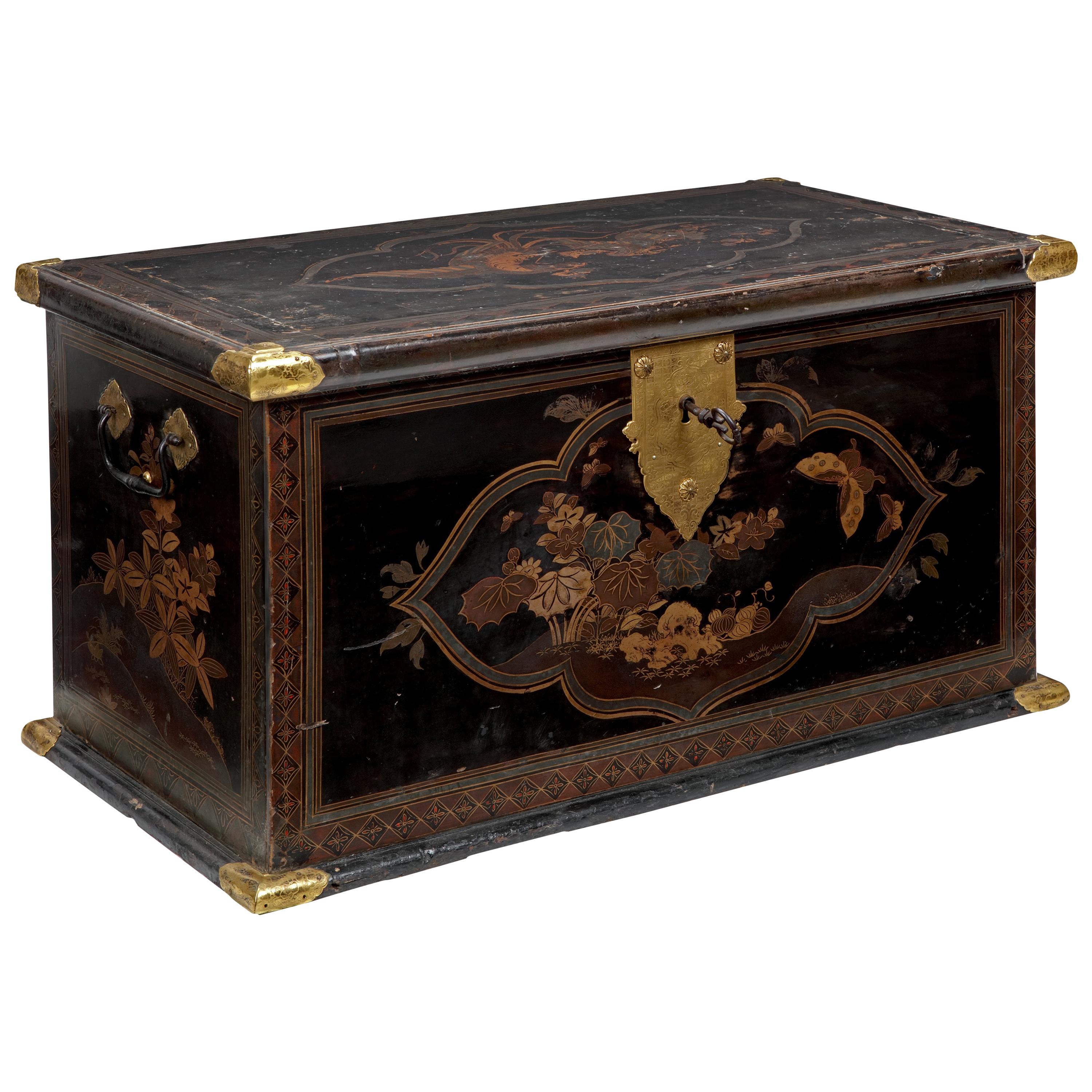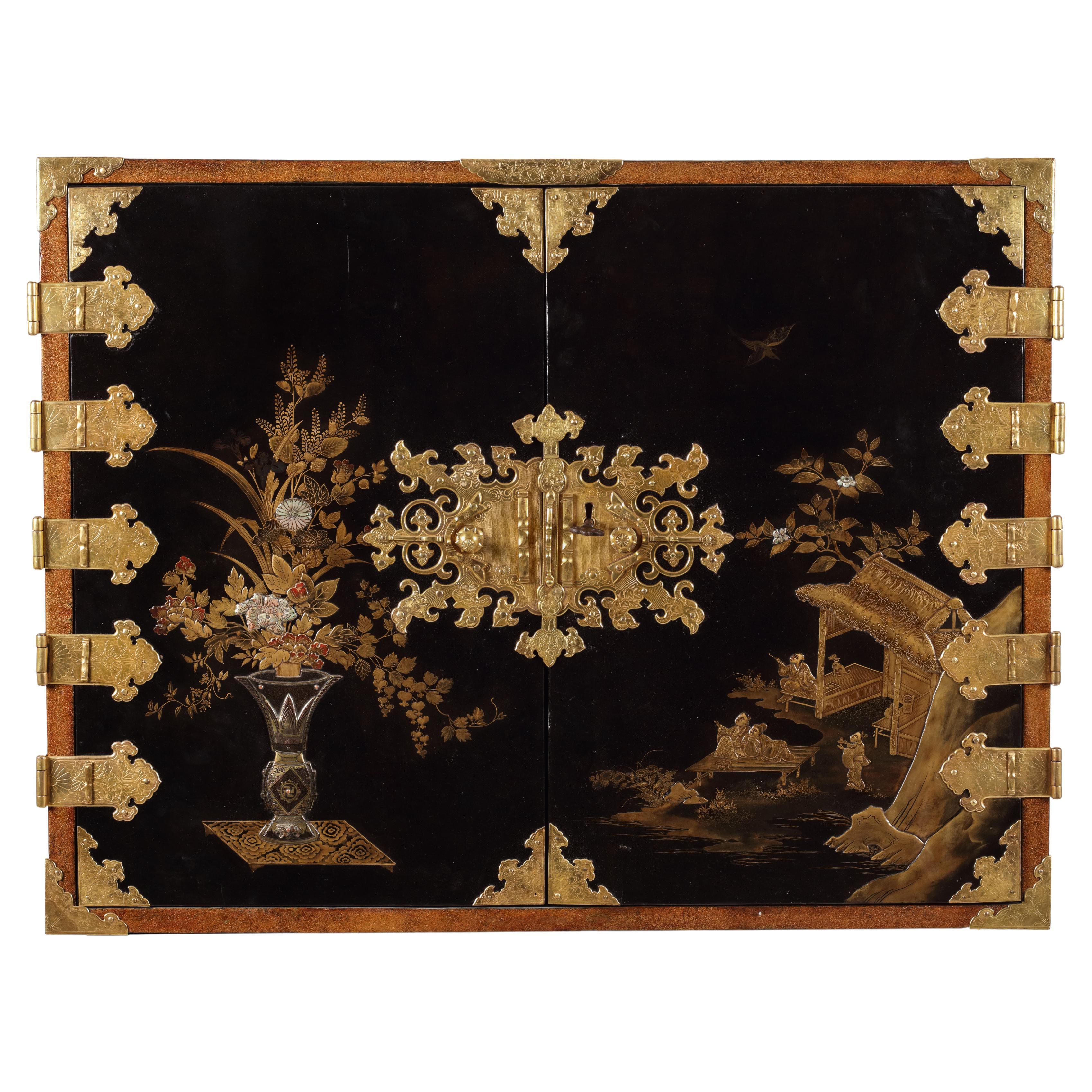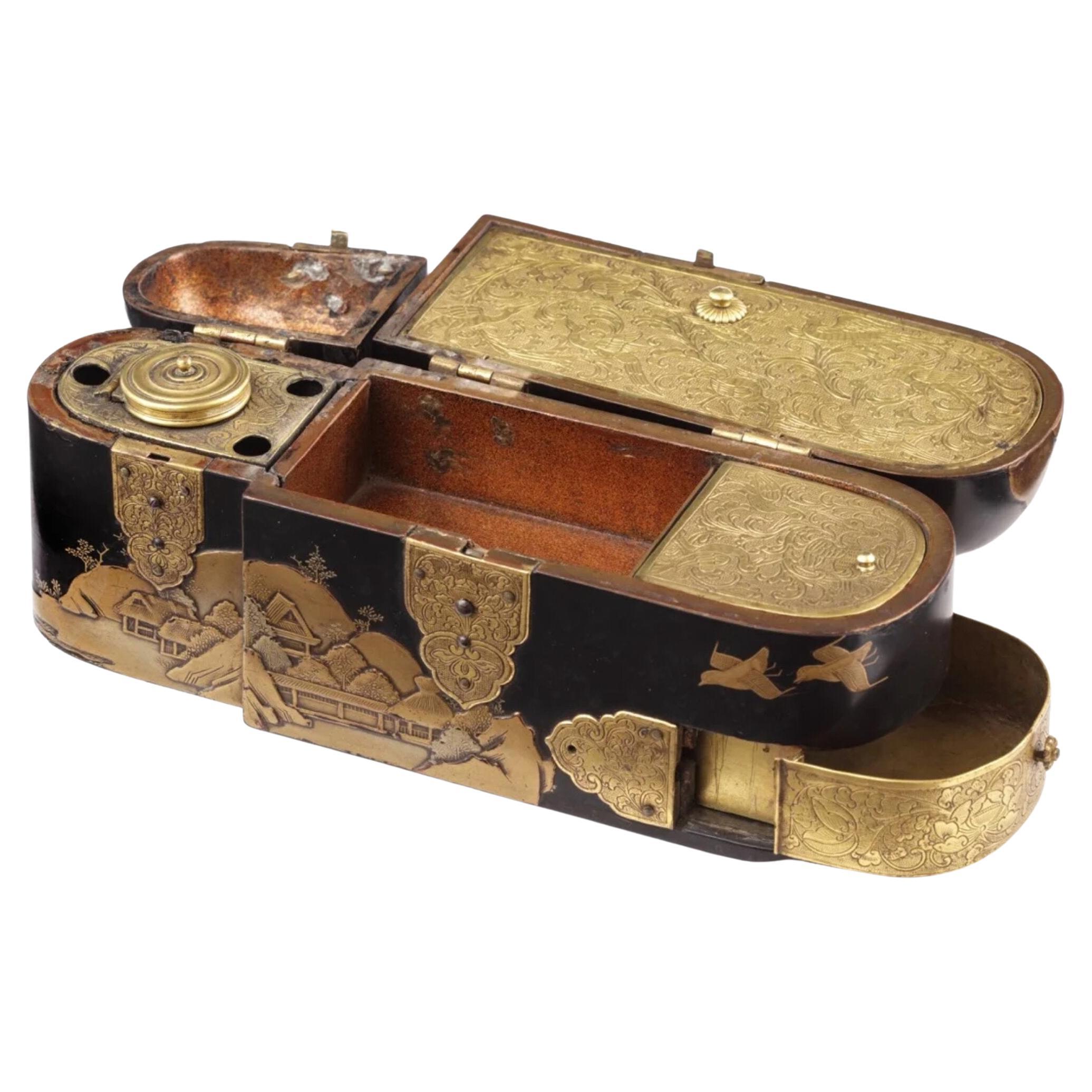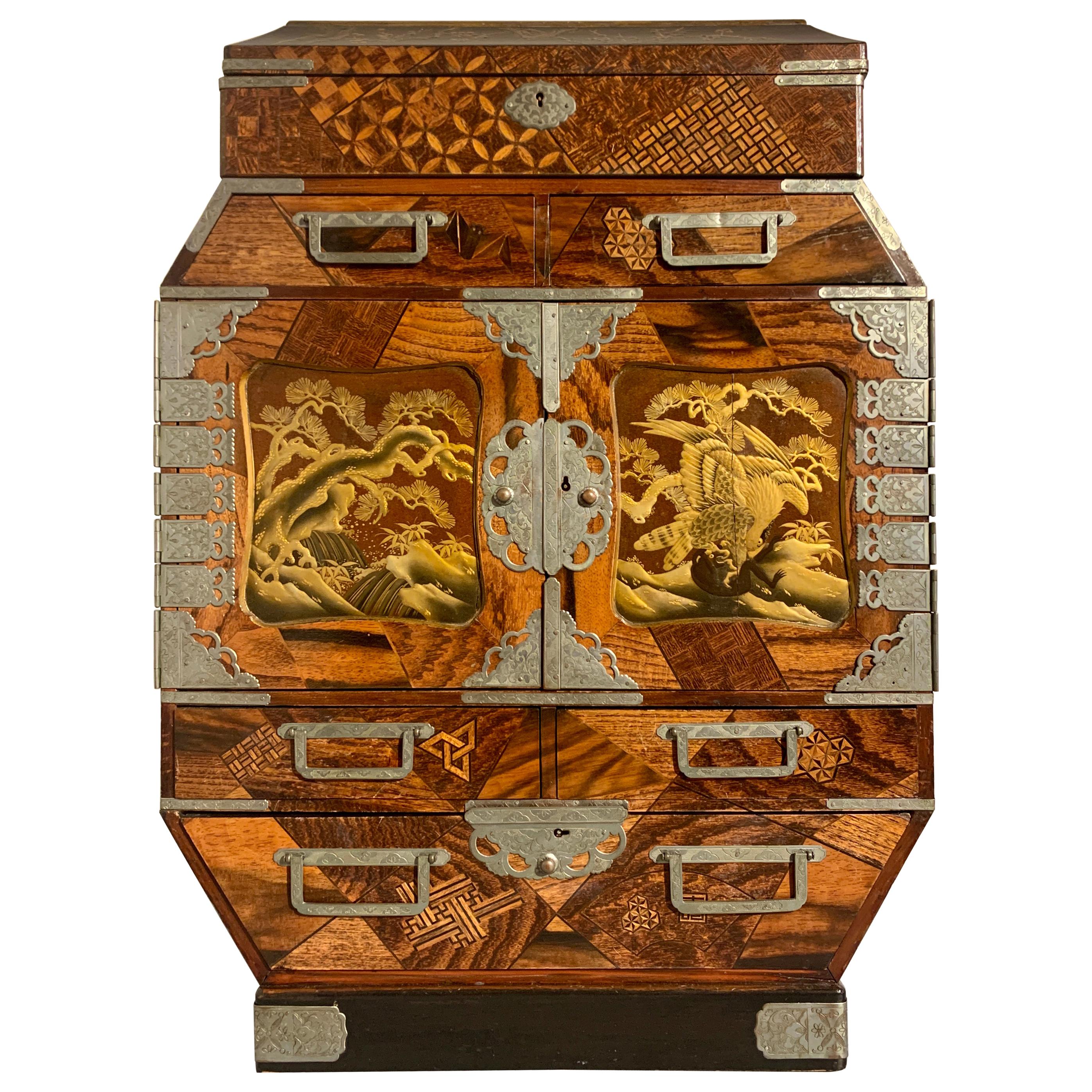Items Similar to Rare Charming 17th Century Japanese Lacquer Cabinet with Gilt-Bronze Mounts
Want more images or videos?
Request additional images or videos from the seller
1 of 5
Rare Charming 17th Century Japanese Lacquer Cabinet with Gilt-Bronze Mounts
About the Item
A fine Japanese pictoral style lacquer cabinet with gilt-metal mounts
Kyoto, Edo period, 1670-1690
Decorated in Japanese relief lacquer work, black lacquer ground decorated in hiramaki-e, takamaki-e, kirigane and nashiji in gold, silver and red, the two hinged doors decorated on the left door with a sitting man and a lying tiger beside him and on the right door a full moon behind a flowering branch, the sides are decorated with bamboos and a bird, the top with a landscape with a pagoda and Mount Fuji in the distance, on the inside of the doors long-tailed birds are depicted and opened the doors reveal ten drawers of different sizes, decorated with a flowering branch within a cartouche and with small gilt-copper mounts in the form of chrysanthemum with a ring attached, the lower drawers to the extreme left and right have engraved metal mounts with keyholes and locks.
Measures: H. 60.5 x W. 61 x D. 46.5 cm
If requested on a modern black powder-coated steel frame.
Note:
Lacquerware originated in China but after it had come to Japan, in the 6th century or earlier, it became part and parcel of Japanese culture and the Japanese eventually surpassed the lacquer work of their Chinese teachers. The first export lacquer, made specifically to the taste of foreigners, was made during the Momoyama period in the late 16th-early 17th century for the Portuguese Jesuits living in Japan and for export to Portugal. This Namban (southern barbarian) style existed when the propagation of the Christian Faith was still permitted in Japan and lingered on till the final expulsion of the Portuguese in 1639.
The Namban style is characterized by the use of gold and silver powder together with profuse mother of pearl inlaying showing dense vine patterns and floral designs, generally including birds and animals all within saw-blade borders.
After the Portuguese were banned from Japan, the Dutch, forced by the Japanese to live on the small artificial island of Deshima in the bay of Nagasaki, were the only Europeans allowed to trade in Japan. The style of the export lacquer ordered by the Dutch changed to a pictorial style of an overall decoration of landscapes without the use of mother-of-pearl and eventually without cartouches and borders.
The present cabinet is a luxurious, expensive object and initially, only the VOC could invest the sums required to buy this type of lacquered cabinet. At the end of the 17th century, however, the Company had to economise on its lacquer orders, notwithstanding the profitable monopoly on its exports. The lacquer trade for the Netherlands dwindled and was given up altogether in the 1690s. Private traders took over, but they rarely could afford large pieces of lacquer and reverted to smaller objects such as tea wares, dishes or small boxes.
For similar examples and a discussion on “Pictorial cabinets without borders on doors” see Oliver Impey and Christiaan Jörg, Japanese Export Lacquer: 1580-1850, 2005, p. 132-134.
- Dimensions:Height: 23.82 in (60.5 cm)Width: 24.02 in (61 cm)Depth: 18.31 in (46.5 cm)
- Materials and Techniques:
- Place of Origin:
- Period:Late 17th Century
- Date of Manufacture:1670-1690
- Condition:Wear consistent with age and use. Minor losses. In pure condition, not restored. Can be restored on request but it is rare to find it in this very good original condition.
- Seller Location:Amsterdam, NL
- Reference Number:1stDibs: LU5458220966802
About the Seller
5.0
Vetted Seller
These experienced sellers undergo a comprehensive evaluation by our team of in-house experts.
Established in 1985
1stDibs seller since 2020
19 sales on 1stDibs
Typical response time: 3 hours
- ShippingRetrieving quote...Ships From: Amsterdam, Netherlands
- Return PolicyThis item cannot be returned.
More From This SellerView All
- 17th Century Japanese Export Lacquer Cabinet with Depiction the Dutch TradepostLocated in Amsterdam, NLA highly important Japanese export lacquer cabinet with depiction of the Dutch East India Company tradepost Deshima and the annual Dutch delegation on its way to the Shogun in Edo Edo period, circa 1660-1680 H. 88 x W. 100.5 x D. 54 cm This cabinet includes a later European japanned stand, but also a modern powder-coated steel frame. The latter can be designed and added to your specific needs. The sides and front of the rectangular two-door cabinet are embellished in gold and silver hiramaki-e and takamaki-e on a black roiro lacquer ground with a continuous design. The two doors depict a long procession of numerous figures travelling on foot and horseback along buildings and a pagoda into a mountainous landscape. This is the annual court journey, Hofreis, of the Dutch from Nagasaki to the Shogun’s court in Edo. Three horseback riders are dressed as Dutch merchants and a fourth figure, probably het Opperhoofd, is seen inside a palanquin, norimon. Just about to cross the bridge, two men are carrying a cabinet like the present one. Many Japanese figures on either side of the procession are engaged in various activities; some play musical instruments on board of small boats, others are fishing; figures inside buildings are depicted playing go, and farmers are tending to their rice paddocks. The upper part of the right door shows a large mansion, probably the local daimyo’s castle, with men kneeling before a man in the central courtyard. The court journey fits in with the foreign policy of the shogunate which accorded a role to the VOC alongside China, Korea, and the Ryukyu Islands who also had to pay tribute. However, the VOC employees were traders, having low status in Japan’s social hierarchy, and they were received with less deference than were the state embassies from Korea and the Ryukyu Islands. Nevertheless, the contacts with the Dutch were a welcome source of information to the Shogun about Europe and European science and technology. The left side of the cabinet depicts, in mirror image, a rare view of the artificial fan-shaped Deshima Island, the trading post for the Dutch in Japan. The island, where the Dutch flag flies, is surrounded by small Japanese boats and an anchored three-masted fluyt (cargo ship), flying Dutch flags, with on the stern the VOC monogram. On the bottom right a busy street of Nagasaki is shown, bordered by shops and leading up to the stone bridge. On the island the trees are beautifully painted, two cows can be seen, and the flagpole, all in very fine detail. Dutchmen and enslaved Malay are visible outside the buildings and two Japanese figures, probably guards, sit in a small hut in the centre. A maximum of fifteen to twenty Dutchmen lived on the island at any time and soldiers or women were not allowed. Restrictions on Deshima were tight, and the merchants were only allowed to leave the island by special permission. The Opperhoofd had to be replaced every year, and each new Opperhoofd had to make a court journey to pay tribute, present gifts, and to obtain permission to Margaret Barclay eep on trading. In the distance, many birds fly above the hills and a four-story pagoda can be seen. The right side of the cabinet is painted with other horse riders and their retinue journeying through mountains. The pair of doors to the front open to reveal ten rectangular drawers. The drawers are decorated with scenes of birds in flight and landscapes with trees and plants. The reverse of the left door with two thatched buildings, one with a ladder, underneath a camelia tree with large blooms; the right door with a three-story pagoda nestled among trees and both doors with a flying phoenix, ho-oo bird. The cabinet, with elaborately engraved gilt copper mounts, hinges, lock plates and brass handles, is raised on an 18th-century English japanned wood stand. A pair of large cabinets...Category
Antique 17th Century Japanese Edo Lacquer
MaterialsCopper, Gold
- Large Royal Early 17th Century Japanese Lacquer Chest with Gilt-Bronze MountsLocated in Amsterdam, NLA large Japanese transitional lacquer chest with gilt-metal mounts Edo period, early 17th century The rectangular chest with flat hinged lid decorated in gold, silver, and red ...Category
Antique Early 17th Century Japanese Blanket Chests
MaterialsBronze
- Extremely Fine and Rare 17th-Century Japanese Export Lacquer and Inlaid CabinetLocated in Amsterdam, NLAn extremely fine and important Japanese lacquer cabinet with gilt-copper mounts for the European market Edo period, late 17th century The pictorial style decorated rectangular...Category
Antique Late 17th Century Japanese Lacquer
MaterialsBrass
- Rare 17th Century Japanese Export Lacquer Medical Instrument BoxLocated in Amsterdam, NLA rare Japanese export lacquer medical instrument box Edo-period, 1650-1700 L. 19 x W. 6 x H. 8.5 cm This unconventionally shaped lacquer b...Category
Antique 17th Century Japanese Edo Lacquer
MaterialsGold
- Fine Japanese Namban Lacquer Jewelry Casket, 17th CenturyLocated in Amsterdam, NLJapanese Namban lacquer transition-style coffer with two drawers Kyoto/Nagasaki, circa 1650 The cartouches with gilt and red decorations of leaves...Category
Antique 17th Century Japanese Edo Lacquer
MaterialsCypress
- Unique 17th Century Miniature Japanese Namban Lacquer Miniature Dollhouse ChestLocated in Amsterdam, NLA unique and exceptional Japanese miniature or dollhouse export lacquered chest Kyoto, circa 1620-1640 The chest of rectangular shape with a domed lid, decorated in Transition-style, in gold hiramaki-e on a black background within reserved lobed cartouches decorated with landscapes animated with birds and rabbits, on a shagreen or samegawa background. The borders are decorated with geometric friezes, the box with gilt-copper mounts, the interior decorated in red lacquer. Measures: H 9.2 x W 14.5 x D 7.2 cm This miniature is of exceptional quality and a perfect copy of the famous large size Transition-style coffers. It was most likely ordered by a Dutch lady for her dollhouse (poppenhuis), like the famous Petronella Oortman (1656-1716) doll-house, which is now one of the highlights in the collection of the Rijksmuseum Amsterdam, or Petronella Oortmans-de la Court’s (1624-1707) dollhouse in the collection of the Centraal Museum Utrecht. Sara Rothé of Amsterdam in 1743 ordered a miniature black lacquered ivory tripod table with gold chinoiserie decoration by Jurriaan Buttner (Monika Kopplin, European Lacquer, 2010, p. 56). Other Japanned dollhouse...Category
Antique 17th Century Japanese Edo Lacquer
MaterialsShagreen, Cypress
You May Also Like
- Japanese Lacquer Display Cabinet on Stand, Meiji Period, 19th Century, JapanLocated in Austin, TXA spectacular Japanese lacquer and porcelain inlaid display cabinet on stand, kazaridana, Meiji Period, late 19th century, Japan. The sumptuous kazaridana of traditional display cabinet form, with several shelves and enclosed spaces for display and storage. The cabinet decorated all over in beautiful maki-e lacquer against a dense nashiji ground and inset with blue and white Arita porcelain plaques. The front of the cabinet of asymmetric design, with two open display shelves at staggered heights, and several doors enclosing storage areas of various shapes and sizes, including one hinged corner door, two pairs of sliding doors, and one pair of hinged doors opening to reveal a rounded inset corner shelf. A pair of drawers below complete the cabinet. All supported on a separate tall fitted stand. The corner door decorated with a bold scene of a samurai warrior fighting a demon. This most likely depicts the warrior Watanabe no Tsuna battling the demon Ibaraki-doji at Rashomon gate, in which Watanabe no Tsuna attempts to help a young girl return home, carrying her on his back, only for the girl to turn into a demon, which he then must fight. The top pair of sliding doors with a scene of a man playing the sho, a Japanese mouth organ, along the banks of a river with a waterfall in the background. The bottom pair of sliding doors with a waterfall scene on one side, while a scholar lounges with his attendants on the other. The pair of hinged doors finely decorated with a pair of fully armored samurai. The two drawers wonderfully decorated in the kodaiji style with a stream of rushing water and various plants and grasses. The cabinet is decorated in the round, with the top, sides, and base of the cabinet decorated with various scenes of flowers and birds, and inset with blue and white Arita porcelain plaques in the form of traditional fan. The fans painted...Category
Antique 1880s Japanese Meiji Lacquer
MaterialsPorcelain, Softwood, Lacquer
- Large Japanese Marquetry Table Cabinet, Meiji Period, Late 19th Century, JapanLocated in Austin, TXA fine and unusually large Japanese table cabinet or jewelry chest with yosegi marquetry work and lacquer paneled doors, Meiji period, late 19th century, Japan. The oversized tab...Category
Antique 1890s Japanese Meiji Furniture
MaterialsBrass
- Japanese Lacquer Meiji Period Cabinet on Stand, circa 1890Located in Brighton, SussexA exquisite, fine quality Meiji period (1868-1912) Japanese black lacquer cabinet on stand with wonderful scrolling gilded decoration. H...Category
Antique Late 19th Century Japanese Japonisme Lacquer
MaterialsLacquer
- Early 20th Century, Showa, a Pair of Japanese Lacquered TraysLocated in Sampantawong, THA pair of Japanese serving lacquered trays. Age: Japan, Showa Period, Early 20th Century Size: height 20.5 cm / width 38 cm / length 69 cm. Condition: Nice condition overall. ...Category
Early 20th Century Japanese Furniture
MaterialsWood
- 19th Century Chinese Export Lacquer and Gilt Davenport DeskLocated in Brea, CAEarly 19th century Chinese export lacquer and gilt Davenport desk, the entire finely decorated with the typical figural landscape and foliate gilt decoration, the sloped top opening ...Category
Antique Early 19th Century Chinese Qing Lacquer
MaterialsLacquer
- 17th Century Japanese Negoro Style Lacquered StandLocated in Fukuoka, JPA Rare Negoro Lacquer Buddhist Stand This rare and historic Negoro lacquer Buddhist stand is a beautiful example of Japanese craftsmanship. It is made of wood with Negoro-style lacq...Category
Antique 17th Century Japanese Lacquer
MaterialsWood, Lacquer
